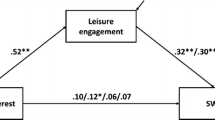Abstract
Leisure engagement, especially sports experiences, has been identified as a robust predictor of subjective well-being (SWB). Two aspects of SWB are hedonic well-being (HWB) and eudaimonic well-being (EWB). HWB emphasizes pleasure and positive affect, whereas EWB involves meaning, purpose, and virtue. The majority of empirical leisure and sports studies, however, have focused on HWB, underexploring leisure’s and sports’ relevance to EWB. Moreover, most studies are limited to Western well-being concepts, whereas people across cultures may conceptualize and experience well-being somewhat differently. Therefore, the purpose of this paper is to examine how sports experiences relate to Japanese well-being concepts, shiawase (happiness, HWB) and ikigai (life worthiness, EWB) among Japanese university students, and how these relationships differ between sport club members and non-members. In Study 1, we analyzed online survey data from 672 students, using partial least squares structural equation modeling. Sports satisfaction had direct links to shiawase and/or ikigai, whereas the effects of sports participation and commitment were mediated by diverse valuable experiences such as enjoyment, stimulation, and comfort. Sports commitment appeared particularly important for sport club members, while sports participation sufficed for non-members. In Study 2, we collected data through a smartphone-based experience sampling method with 83 students for one week. Hierarchical linear modeling results showed that sports participation was associated with greater daily ikigai, while it was unrelated to shiawase. The association between sports participation and daily ikigai was stronger among sport club non-members. We discuss overall findings in relation to student mental health and campus recreation administration.

Similar content being viewed by others
References
Abdel-Khalek, A. M. (2005). Measuring happiness with a single-item scale. Social Behavior and Personality: An International Journal, 34(2), 139–150. https://doi.org/10.2224/sbp.2006.34.2.139
Alexandris, K., Zahariadis, P., Tsorbatzoudis, C., & Grouios, G. (2004). An empirical investigation of the relationships among service quality, customer satisfaction and psychological commitment in a health club context. European Sport Management Quarterly, 4(1), 36–52. https://doi.org/10.1080/16184740408737466
Andrews, F. M., & Withey, S. B. (1976). Social indicators of well-being: America’s perception of life quality. Plenum Press
Cabinet, Office, & Government of Japan. (1994). Kokumin seikatsu ni kansuru yoron chyousa [A poll on citizens’ life]. http://survey.gov-online.go.jp/h06/H06-05-06-01.html
Cave, P. (2004). “Bukatsudō”: The educational role of Japanese school clubs. The Journal of Japanese Studies, 30(2), 383–415
Cheung, F., & Lucas, R. E. (2014). Assessing the validity of single-item life satisfaction measures: Results from three large samples. Quality of Life Research, 23, 2809–2818. https://doi.org/10.1007/s11136-014-0726-4
Choi, J., Catapano, R., & Choi, I. (2017). Taking stock of happiness and meaning in everyday life: An experience sampling approach. Social Psychological and Personality Science, 8(6), 641–651. https://doi.org/10.1177/1948550616678455
Cicchetti, D. V. (1994). Guidelines, criteria, and rules of thumb for evaluating normed and standardized assessment instruments in psychology. Psychological Assessment, 6(4), 284–290. https://doi.org/10.1037/1040-3590.6.4.284
Cohen, J. (1992). A power primer. Psychological Bulletin, 112, 155–159. https://doi.org/10.1037/0033-2909.112.1.155
Diener, E., Lucas, R. E., & Oishi, S. (2018). Advances and open questions in the science of subjective well-being. Collabra: Psychology, 4(1), 1–19. https://doi.org/10.1525/collabra.115
Enders, C. K., & Tofighi, D. (2007). Centering predictor variables in cross-sectional multilevel models: A new look at an old issue. Psychological Methods, 12(2), 121–138. https://doi.org/10.1037/1082-989X.12.2.121
Exel, J., Mateus, N., Travassos, B., Gonçalves, B., Gomes, I., Leite, N., & Sampaio, J. (2018). Off-training levels of physical activity and sedentary behavior in young athletes: Preliminary results during a typical week. Sports, 6(4), 141. https://doi.org/10.3390/sports6040141
Fast, J., & Frederick, J. (2004). The time of our lives: Juggling work and leisure over the life cycle. Statistics Canada
Filo, K., & Coghlan, A. (2016). Exploring the positive psychology domains of well-being activated through charity sport event experiences. Event Management, 20(2), 181–199. https://doi.org/10.3727/152599516X14610017108701
Garson, G. D. (2013). Introductory guide to HLM with HLM 7 software. In G. D. Garson (Ed.), Hierarchical linear modeling: Guide and applications (pp. 55–96). Sage
Giamos, D., Lee, A. Y. S., Suleiman, A., Stuart, H., & Chen, S. P. (2017). Understanding campus culture and student co** strategies for mental health issues in five Canadian colleges and universities. Canadian Journal of Higher Education, 47(3), 136–151. https://doi.org/10.7202/1043242ar
Gwet, K. L. (2014). Handbook of inter-rater reliability: The definitive guide to measuring the extent of agreement among raters (4th ed.). Advanced Analytics
Hair, J. F. Jr., Hult, G. T. M., Ringle, C. M., & Sarstedt, M. (2017). A primer on partial least squares structural equation modeling (PLS-SEM) (2nd ed.). Sage
Hektner, J. M., Schmidt, J. A., & Csikszentmihalyi, M. (2007). Experience sampling method: Measuring the quality of everyday life. Sage
Hox, J., & McNeish, D. (2020). Small samples in multilevel modeling. In van de R. Schoot, & M. Miočevic (Eds.), Small sample size solutions: A guide for applied researchers and practitioners (pp. 215–225). Routledge
Huta, V., & Waterman, A. S. (2014). Eudaimonia and its distinction from hedonia: Develo** a classification and terminology for understanding conceptual and operational definitions. Journal of Happiness Studies, 15(6), 1425–1456. https://doi.org/10.1007/s10902-013-9485-0
Inoue, Y., Sato, M., & Filo, K. (2020). Transformative sport service research: Linking sport services with well-being. Journal of Sport Management, 34(4), 285–290. https://doi.org/10.1123/jsm.2020-0102
Iwata, K. (2015). University students’ life satisfaction: Determinants as seen from a survey of 26 universities. Momoyamagakuindaigaku Sougoukenkyuujyokiyou, 40(2), 67–85
Kamiya, M. (1966). Ikigai ni tsuite [On ikigai]. Misuzu Shyobou
Kanezaki, R. (2000). Shyougai supoutsu no riron. [a theory of lifelong sports]. Fumaido
Kim, J. H., Brown, S. L., & Yang, H. (2019). Types of leisure, leisure motivation, and well-being in university students. World Leisure Journal, 61(1), 43–57. https://doi.org/10.1080/16078055.2018.1545691
Kim, J., Kim, Y., & Kim, D. (2017). Improving well-being through hedonic, eudaimonic, and social needs fulfillment in sport media consumption. Sport Management Review, 20(3), 309–321. https://doi.org/10.1016/j.smr.2016.10.001
King, C., Heo, J., Lee, J. W., Hji-Avgoustis, S., & Lee, S. (2020). Subjective well-being, activity types, and social context in undergraduate students’ daily experiences: An experience sampling study. College Student Journal, 54(1), 106–116
Kondo, T. (2007). Ikigai wo hakaru: Ikigai-kan te nani?. [Measuring ikigai: What is perceived ikigai?]. Nakanishiya Shyuppan
Kono, S., Walker, G. J., Ito, E., & Hagi, Y. (2019). Theorizing leisure’s roles in the pursuit of ikigai (life worthiness): a mixed-methods approach. Leisure Sciences, 41(4), 237-259. https://doi.org/10.1080/01490400.2017.1356255
Kono, S., & Walker, G. J. (2020a). Theorizing ikigai or life worth living among Japanese university students: A mixed-methods approach. Journal of Happiness Studies, 21(1), 327–355. https://doi.org/10.1007/s10902-019-00086-x
Kono, S., & Walker, G. J. (2020b). Theorizing the interpersonal aspect of ikigai (‘life worth living’) among Japanese university students: A mixed-methods approach. International Journal of Wellbeing, 10(2), 101–123. https://doi.org/10.5502/ijw.v10i2.979
Kumano, M. (2018). On the concept of well-being in Japan: Feeling shiawase as hedonic well-being and feeling ikigai as eudaimonic well-being. Applied Research in Quality of Life, 13(2), 419–433. https://doi.org/10.1007/s11482-017-9532-9
Kuramoto, K., & Kikuchi, H. (2006). University student motivation to participate in organized sports: Comparing intercollegiate athletes and intramural club players. Chyukyoudaigaku-Taiikugaku-Ronsou, 47(1), 37–48
Kuykendall, L., Tay, L., & Ng, V. (2015). Leisure engagement and subjective well-being: A meta-analysis. Psychological Bulletin, 141(2), 364–403. https://doi.org/10.1037/a0038508
Lomas, T. (2016). Towards a positive cross-cultural lexicography: Enriching our emotional landscape through 216 ‘untranslatable’ words pertaining to well-being. The Journal of Positive Psychology, 11(5), 546–558. https://doi.org/10.1080/17439760.2015.1127993
Lower, L. M., Turner, B. A., & Petersen, J. C. (2013). A comparative analysis of perceived benefits of participation between recreational sport programs. Recreational Sports Journal, 37, 66–83. https://doi.org/10.1123/rsj.37.1.66
Litwiller, F., White, C., Hamilton-Hinch, B., & Gilbert, R. (2022). The impacts of recreation programs on the mental health of postsecondary students in North America: An integrative review. Leisure Sciences, 44(1), 96–120. https://doi.org/10.1080/01490400.2018.1483851
Lucas, R. E., & Brent Donnellan, M. B. (2012). Estimating the reliability of single-item life satisfaction measures: Results from four national panel studies. Social Indicators Research, 105, 323–331. https://doi.org/10.1007/s11205-011-9783-z
McDonald, B. D. (2009). Learning masculinity through Japanese university rowing. Sociology of Sport Journal, 26(3), 425–442. https://doi.org/10.1123/ssj.26.3.425
Neuendorf, K. A. (2017). The content analysis guidebook (2nd ed.). Sage
Oishi, S. (2009). Shiawase wo kagaku suru: Shinrigaku kara wakatta koto [Doing science of happiness: What we learned from psychology]. Shinyoushya
Raedeke, T. D. (1997). Is athlete burnout more than just stress? A sport commitment perspective. Journal of Sport and Exercise Psychology, 19(4), 396–417
Sato, M., Jordan, J. S., & Funk, D. C. (2015). Distance running events and life satisfaction: A longitudinal study. Journal of Sport Management, 29(4), 347–361. https://doi.org/10.1123/jsm.2013-0164
Sato, S., Oshimi, D., Harada, M., Sato, M., Asakura, M., & Ko, Y. J. (2015). The effects of sport consumers’ goal types and goal valence on satisfaction and happiness. Sport Science Research, 12, 101–120
Scanlan, T. K., Carpenter, P. J., Schmidt, G. W., Simons, J. P., & Keeler, B. (1993). An introduction to the sport commitment model. Journal of Sport & Exercise Psychology, 15(1), 1–15
Shimai, S., Otake, K., Utsuki, N., Ikemi, A., & Lyubomirsky, S. (2004). Development of a Japanese version of the Subjective Happiness Scale (SHS), and examination of its validity and reliability. Nihon Koueishi, 51(10), 845–853
Snijders, T. A. B., & Bosker, R. J. (2011). Multilevel analysis: An introduction to basic and advanced multilevel modeling (2nd ed.). Sage
Sommet, N., & Morselli, D. (2017). Keep calm and learn multilevel logistic modeling: A simplified three-step procedure using stata, R, Mplus, and SPSS. International Review of Social Psychology, 30, 203–218. https://doi.org/10.5334/irsp.90
Steger, M. F., Kashdan, T. B., & Oishi, S. (2008). Being good by doing good: Daily eudaimonic activity and well-being. Journal of Research in Personality, 42(1), 22–42. https://doi.org/10.1016/j.jrp.2007.03.004
Suzue, T. (2018). Study about mental unhealthiness of university students and suicide prevention. Shizuokadaigaku Kyouikugakubu Kenkyuuhoukoku, 68, 211–218
Tabachnick, B. G., & Fidell, L. S. (2013). Using multivariate statistics (6th ed.). Pearson Education
Thai, S., & Page-Gould, E. (2018). ExperienceSampler: An open-source scaffold for building smartphone apps for experience sampling. Psychological Methods, 23(4), 729–739. https://doi.org/10.1037/met0000151
Uchida, Y., & Ogihara, Y. (2012). Cultural construal of happiness: Cultural psychological perspectives and future direction of happiness research. Japanese Psychological Review, 55(1), 26–42
Walker, G. J., Halpenny, E., Spiers, A., & Deng, J. (2011). A prospective panel study of Chinese-Canadian immigrants’ leisure participation and leisure satisfaction. Leisure Sciences, 33(5), 349–365. https://doi.org/10.1080/01490400.2011.606776
Warner, S., Dixon, M. A., & Chalip, L. (2012). The impact of formal versus informal sport: Map** the differences in sense of community. Journal of Community Psychology, 40(8), 983–1003. https://doi.org/10.1002/jcop.21506
Wiese, C. W., Kuykendall, L., & Tay, L. (2018). Get active? A meta-analysis of leisure-time physical activity and subjective well-being. The Journal of Positive Psychology, 13(1), 57–66. https://doi.org/10.1080/17439760.2017.1374436
Author information
Authors and Affiliations
Corresponding author
Ethics declarations
The authors declare that they have no conflict of interest. This study was supported by Sasakawa Sports Research Grants (160A3-011, 180A3-005) from the Sasakawa Sports Foundation (Japan) awarded to the second author.
Additional information
Publisher’s Note
Springer Nature remains neutral with regard to jurisdictional claims in published maps and institutional affiliations.
Electronic supplementary material
Below is the link to the electronic supplementary material.
Rights and permissions
Springer Nature or its licensor holds exclusive rights to this article under a publishing agreement with the author(s) or other rightsholder(s); author self-archiving of the accepted manuscript version of this article is solely governed by the terms of such publishing agreement and applicable law.
About this article
Cite this article
Kono, S., Ito, E., Okayasu, I. et al. Understanding How Sports Relate to Hedonic and Eudaimonic Well-Being Among Japanese University Students. Int J Sociol Leis 6, 27–54 (2023). https://doi.org/10.1007/s41978-022-00114-w
Received:
Revised:
Accepted:
Published:
Issue Date:
DOI: https://doi.org/10.1007/s41978-022-00114-w




